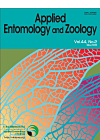36 巻, 1 号
選択された号の論文の25件中1~25を表示しています
- |<
- <
- 1
- >
- >|
Mini Review
-
原稿種別: Review
専門分野: [not specified]
2001 年 36 巻 1 号 p. 1-11
発行日: 2001年
公開日: 2003/03/25
PDF形式でダウンロード (105K)
Regular Papers
-
原稿種別: Regular Paper
専門分野: [not specified]
2001 年 36 巻 1 号 p. 13-17
発行日: 2001年
公開日: 2003/03/25
PDF形式でダウンロード (79K) -
原稿種別: Regular Paper
専門分野: [not specified]
2001 年 36 巻 1 号 p. 19-23
発行日: 2001年
公開日: 2003/03/25
PDF形式でダウンロード (70K) -
原稿種別: Regular Paper
専門分野: [not specified]
2001 年 36 巻 1 号 p. 25-32
発行日: 2001年
公開日: 2003/03/25
PDF形式でダウンロード (78K) -
原稿種別: Regular Paper
専門分野: [not specified]
2001 年 36 巻 1 号 p. 33-40
発行日: 2001年
公開日: 2003/03/25
PDF形式でダウンロード (148K) -
原稿種別: Regular Paper
専門分野: [not specified]
2001 年 36 巻 1 号 p. 41-45
発行日: 2001年
公開日: 2003/03/25
PDF形式でダウンロード (53K) -
原稿種別: Regular Paper
専門分野: [not specified]
2001 年 36 巻 1 号 p. 47-52
発行日: 2001年
公開日: 2003/03/25
PDF形式でダウンロード (86K) -
原稿種別: Regular Paper
専門分野: [not specified]
2001 年 36 巻 1 号 p. 53-58
発行日: 2001年
公開日: 2003/03/25
PDF形式でダウンロード (74K) -
原稿種別: Regular Paper
専門分野: [not specified]
2001 年 36 巻 1 号 p. 59-69
発行日: 2001年
公開日: 2003/03/25
PDF形式でダウンロード (582K) -
原稿種別: Regular Paper
専門分野: [not specified]
2001 年 36 巻 1 号 p. 71-76
発行日: 2001年
公開日: 2003/03/25
PDF形式でダウンロード (78K) -
原稿種別: Regular Paper
専門分野: [not specified]
2001 年 36 巻 1 号 p. 77-81
発行日: 2001年
公開日: 2003/03/25
PDF形式でダウンロード (89K) -
原稿種別: Regular Paper
専門分野: [not specified]
2001 年 36 巻 1 号 p. 83-89
発行日: 2001年
公開日: 2003/03/25
PDF形式でダウンロード (100K) -
原稿種別: Regular Paper
専門分野: [not specified]
2001 年 36 巻 1 号 p. 91-95
発行日: 2001年
公開日: 2003/03/25
PDF形式でダウンロード (242K) -
原稿種別: Regular Paper
専門分野: [not specified]
2001 年 36 巻 1 号 p. 97-102
発行日: 2001年
公開日: 2003/03/25
PDF形式でダウンロード (62K) -
原稿種別: Regular Paper
専門分野: [not specified]
2001 年 36 巻 1 号 p. 103-109
発行日: 2001年
公開日: 2003/03/25
PDF形式でダウンロード (66K) -
原稿種別: Regular Paper
専門分野: [not specified]
2001 年 36 巻 1 号 p. 111-116
発行日: 2001年
公開日: 2003/03/25
PDF形式でダウンロード (60K) -
原稿種別: Regular Paper
専門分野: [not specified]
2001 年 36 巻 1 号 p. 117-120
発行日: 2001年
公開日: 2003/03/25
PDF形式でダウンロード (50K) -
原稿種別: Regular Paper
専門分野: [not specified]
2001 年 36 巻 1 号 p. 121-125
発行日: 2001年
公開日: 2003/03/25
PDF形式でダウンロード (45K) -
原稿種別: Regular Paper
専門分野: [not specified]
2001 年 36 巻 1 号 p. 127-136
発行日: 2001年
公開日: 2003/03/25
PDF形式でダウンロード (71K) -
原稿種別: Regular Paper
専門分野: [not specified]
2001 年 36 巻 1 号 p. 137-141
発行日: 2001年
公開日: 2003/03/25
PDF形式でダウンロード (41K) -
原稿種別: Regular Paper
専門分野: [not specified]
2001 年 36 巻 1 号 p. 143-149
発行日: 2001年
公開日: 2003/03/25
PDF形式でダウンロード (63K) -
原稿種別: Regular Paper
専門分野: [not specified]
2001 年 36 巻 1 号 p. 151-160
発行日: 2001年
公開日: 2003/03/25
PDF形式でダウンロード (115K) -
原稿種別: Regular Paper
専門分野: [not specified]
2001 年 36 巻 1 号 p. 161-167
発行日: 2001年
公開日: 2003/03/25
PDF形式でダウンロード (117K) -
Overwintering ecology of two species of spider mites (Acari: Tetranychidae) on different host plants原稿種別: Regular Paper
専門分野: [not specified]
2001 年 36 巻 1 号 p. 169-175
発行日: 2001年
公開日: 2003/03/25
PDF形式でダウンロード (185K) -
原稿種別: Regular Paper
専門分野: [not specified]
2001 年 36 巻 1 号 p. 177-184
発行日: 2001年
公開日: 2003/03/25
PDF形式でダウンロード (109K)
- |<
- <
- 1
- >
- >|
